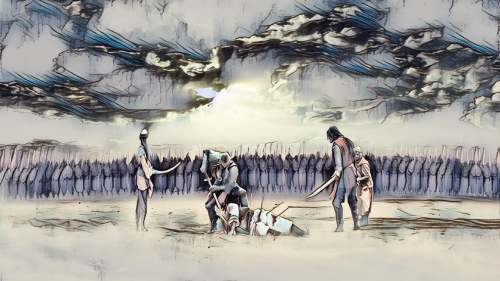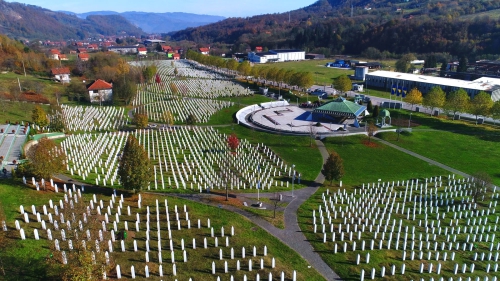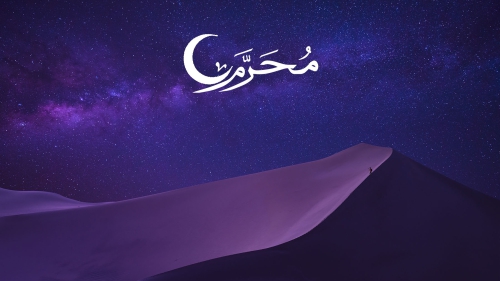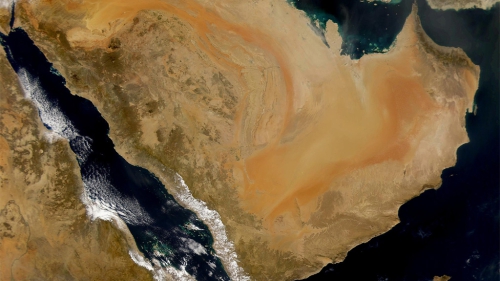Serbian Islamophobia: St. Sava, Njegoš & Srđa Trifković

This article is an excerpt from the author’s forthcoming book titled “Serbian Islamophobia: St. Sava, Njegoš & Srđa Trifković”
Though a moving target in terms of its definition, origins and evolutionary development, Islamophobia can be defined as the excessive and empirically unjustifiable fear, hatred of, or bias against Islam, Muslims and Islamic civilization, which are translated into policies, attitudes, language, literature, and into condoned individual, along with collective, behavioural patterns. Islamophobia is a new and fancy term for a centuries-old – yet millennia-old - idea and phenomenon. Differences from one era and its context to another were in nuances and methods, rather than in character, magnitudes and goals. While at first and for a long time Islamophobia was in the spirit of “us versus them”, in recent times it came to be, principally, in terms of “them among us”.
Islamophobia as an antediluvian trend
Life on earth is an intricate network of interactions between opposites. However, many of those interactions under favourable conditions easily mutate into conflicts, making the face of the earth an arena of vivacity and dynamism, on the one hand, and of contrasts, tensions and even paradoxes, on the other. Islam, moreover, is the only religion of Allah meant for man and his worldly excursion: “Indeed, the religion in the sight of Allah is Islam (only)” (Alu ‘Imran, 19); “And whoever desires other than Islam as religion - never will it be accepted from him, and he, in the Hereafter, will be among the losers” (Alu ‘Imran, 85). Thus, since the inception of mankind’s stay on earth - from the time of first man and prophet, Adam – Islam and prophets, whose task was to convey and teach Islam, were life’s permanent companions.
By dint of the laws of terrestrial interactions and conflicts, whenever and wherever there was Islam as the absolute truth (nur and huda, light and guidance), there were its antitheses as well. There were plentiful forms of falsehood (zulumat and dhalal, darknesses and misguidance), and there were satans from the ranks of both the jinn and mankind, and a great many armies of theirs. Employing the Qur’anic vocabulary, there were two parties: the party of Allah (hizb Allah) and the party of Satan (hizb al-shaytan).
No sooner had the Almighty God’s plan for the earthly existence been unveiled - in the thick of which stood man and his principled vicegerency mission – than the implied state of affairs stepped to the fore. It was set in motion at that point, after which it never quietened down. The matter is indicated in the words of angels to God as to the looming terrestrial destiny of man: “Will You place upon it one who causes corruption therein and sheds blood?” (al-Baqarah, 30), and in the accentuated animosity between Satan and his followers (truth-deniers) and Adam the father of mankind and his progeny, in particular the believers: “And We said: ‘Go down, (all of you), as enemies to one another” (al-Baqarah, 36).
In the same vein, the Qur’an informs us that while Satan will leave no stone unturned in looking for ways and means to cause man to fall, he at the same time is weak, fears God, dreads the triumphs of the truth and its people, and is filled with hate towards everything positive affiliated with the truth and the party of Allah (hizb Allah). Satan’s and satanic worlds, it follows, stand for an amalgam of trepidation, revulsion and endless intrigues. In opposition, the believers are counselled to be steadfast, well-equipped and strong in resisting Satan’s and his party’s encroachments. Though the attacks will be incessant and lethal, the believers have what it takes to overcome them and succeed. The world of the believers, therefore, is one of perpetual alertness, vigour and optimism. It is the world of goodness and beauty; that is why it is targeted.
This means that Islamophobia - as a triad of fear of, hate towards, and action against Islam and Muslims - is as old as humanity itself and is as active as the existential mandate of man itself. The first Islamophobe, it goes without saying, was Satan, and the first victim Adam and his wife. Whoever thenceforth and till our modern times followed in the footsteps of Satan, he or she was qualified to be dubbed an Islamophobe. The problem is one of unity and consistency of substance, and diversity of manifestations and tags. The Qur’an repeatedly calls such a behavioural pattern on the part of truth-deniers (Satan’s faction) as “plots”, “schemes”, “plans”, “resentments” and “ill-treatments.” The word Islamophobia is just the latest tag for some of the present-day manifestations relating to the antediluvian trend.
The ancient Islamophobia is perhaps best epitomized in the following Qur’anic declarations: “But the answer of his (Prophet Lut’s) people was only that they said: ‘Evict them (Lut and his people) from your city! Indeed, they are men who keep themselves pure’” (al-A’raf, 82); “And those who disbelieved said to their messengers (recurrently throughout human history): ‘We will surely drive you out of our land, or you must return to our religion’” (Ibrahim, 13). So, the followers of prophets, who were minorities most of the time, were rejected, denigrated and abused merely because they were believers (wanted to purify themselves from all sorts of physical and spiritual impurities). Their wrongdoing was that they were different, and that, perchance, one day they could upset national – or even transnational - status quos. Given this, Islamophobia and paranoia are twin ailments.
The fathers of the Serbian Islamophobia
In my book titled “Islamophobia and Islamic Moderation”, which was published in 2022 by the Dar Al Wahi Publication in Kuala Lumpur, some general aspects of Islamophobia: definition, characteristics, history and manifestations, have been dealt with. This book has a very specific aim, namely to examine the concept and phenomenon of Serbian Islamophobia. This is done by analysing the Islamophobic roles and contributions of three prominent Serbian personalities, exemplifying thus three different eras and three mutually complementing approaches.
Those personalities are: Saint Sava (d. 1236), who lived prior to the arrival of the Osmanlis (Ottomans) on the Balkan Peninsula; Petar II Petrović Njegoš (d. 1851), whose epoch was marked by the waning of the Osmanli power in the region and beyond; and Srđa Trifković (born in 1954), whose case represents the turbulent modern times. The adjective “Serbian”, as in the title of the book, is synonymous with the adjective “Serb”, encompassing Serbia as a country and the Serbs as a people.
The book shows that in addition to the typical Western epicentres of Islamophobia - such as France, America and England - Serbia and Serbdom (the Serb people wherever they lived), though often discounted in Islamophobic discourses, played a prominent role, too. They excelled both in theory and practice. The Serbian lands, culture and thought developed into hotbeds of Islamophobia in compliance with the highest international standards. Right through the ages, the European Islamophobic counterparts constantly had something to learn from the Serbs and their Islamophobia paradigm. The avant-garde Islamophobes of Serbia stood at the forefront of guarding Europe and defending its increasingly endangered Christian character and values. This way, Serbia served as a bulwark of the self-proclaimed Christian Europe against the peril of Islam (the antemurale myth).
The Serbian Islamophobia and the Serbian nationalism
Serbian Islamophobia is mixed with Serbian nationalism. The fusion is so strong and so subtle that they became almost identical. To be a Serbian nationalist means to be a Serbian Islamophobe, one way or another, and vice versa. This is the case because for the majority of Serbs, religion (Serbianized Orthodox Christianity) and ethnicity (Serbism) are one and the same. Serbism as a nationalist ideology comprises at once the state and religion (the Serbian Orthodox Church). To be a Serb one has to swear allegiance to the two dominions. Betraying either the state or religion is an act of treason.
However, if one was to decide which ambit was more important: ethnicity or religion, it would be the former. The ethnicity preponderates over religion, rendering it subservient to the former’s interests and designs. That means that the inviolability of Serbism is supreme. Thus, from the perspective of Serbism as a nationalist agenda, a good Serb is he who is a nationalist first and a religious enthusiast second; who, in other words, was ready to sacrifice himself on the altar of nation (ethnicity) above all, and then on the altar of religion. Unlike the latter, the former could not be tampered with, hence the religious associations were tied to, yet dictated by, those of nation, making them practically unalterable as well.
For this reason, those Serbs who had once become Muslims were regarded as national traitors and apostates, whose sins were unforgivable, not as much because they walked out on the religious beliefs of their forefathers – by the way, all South Slavs were formerly pagans - as because they betrayed Serbism and the Serbian ethnocentrism so painstakingly built and cherished by the giants of earlier generations. Indeed, religious nationalism was a gateway to Serbian nationalism, and the Serbian Church a tool of Serbism. Thus, according to the thinking of Serbian nationalists, those traitors and apostates must either revert to Serbianized Orthodox Christianity or leave Serbdom. An in-between option was extermination. History bears witness to numerous instances of all the three alternatives.
About how Serbism and Serbianized Orthodox Christianity were interrelated and to what extent the latter was in the service of the former, gives evidence for the statement of Veljko Vujačić in his book titled “Nationalism, Myth, and the State in Russia and Serbia.” The author says: “The Orthodox Church played an important role by preserving and reviving the memory of the Serbian medieval state and its ruling Nemanjić dynasty. Of particular significance were the rationalization of the church calendar and the canonization of church saints, through which the rulers of medieval Serbia were accorded saintly status. While the traditional cult of St. Sava retained its central place, it was now supplemented by the sanctification of the secular rulers.”
To be exact, religion became nationalized thereby and nation spiritualized and canonized. Voyeslav Yanich and Patrick Hankey, the authors of a book “Lives of the Serbian Saints”, likewise said that the list of the Serbian saints, by and large, comprises kings and great churchmen. The reason for that is that “they are the men who made the Serbians an independent people and built up the short-lived Serbian Empire” which was governed by an alliance of the political and religious leaderships.
St. Sava, Njegoš & Srđa Trifković
Prior to the advent of the Osmanlis (Ottomans) on the Balkan Peninsula, when both the Serbian Orthodox Church and Serbism were in their infancy, the Serbian Islamophobia - which was also in its embryonic phase - was restricted to the Serbian religious and political elites. The trend was epitomized by St. Sava, who was the founder of Serbian law and also the founder of the Serbian Orthodox Church, and who was instrumental in the creation of an independent Serbian state.
St. Sava’s contributions to Islamophobia were in terms of preparing the Serbian society and the Serbian mind for the imminent confrontations with what increasingly looked as the unavoidable peril, namely the spread of the religion of Islam and Muslims as its followers and propagators. St. Sava furthermore was content to project the Serbian nation and its people as the protectors of Europe’s Christian identity and values against the approaching invasion of Islam and Muslims. The Serbs functioned as a bulwark or Europe’s front wall against the continent’s biggest threat yet. All the same, St. Sava was ignorant about Islam and was not up to the mark. His Islamophobia was crude and absurdly benighted.
Following the civilizational decline of the Osmanlis in the Balkans and elsewhere, the Serbian Islamophobia came to be as much enhanced as diversified. The tendency was commensurate with the worsening of the Osmanli socio-political and cultural presence. The weaker and more alienated the Osmanlis had grown to be, due to a myriad of internal and external factors, the more audacious and more belligerent the Serbs became. Those developments were personified by the case of Petar II Petrović Njegoš and his poem and play “The Mountain Wreath” (“Gorski Vijenac”). The epic is a national treasure of the Montenegrins and Serbs, for which Njegoš is held as the greatest Serbian poet and his “The Mountain Wreath” as the ultimate achievement in Serbian literature.
However, “The Mountain Wreath”, at the same time, is a manual for Islamophobia. Taking into account the background of Njegoš’s Islamophobic and Serbian nationalistic activities, the opus is also a genocidal blueprint. It combines theory and practice, setting high standards for future Islamophobes across the globe, who, just like Njegoš, will be happy to transport the quintessence of Islamophobia from the jurisdiction of theory to that of specific acts of terror. “The Mountain Wreath” ideologizes, justifies and propagates a genocide model against any Muslim community that may stand in the way of the realization of the unholy vision of a Great(er) Serbia.
The work moreover lays down the rules for the viciousness and inhumanity of the envisioned Islamophobic designs. It points the way forward by effecting a cycle of slaughters of several Muslim populations in Montenegro, obliterating the traces of Islam’s and Muslims’ presence in the affected areas. All the talk about the literary quality of “The Mountain Wreath” and the scholarly brilliance of Njegoš, before and now, is but a strategy to cover up the true intentions and aims. It is a decoy. Accordingly, Njegoš was a genocidal ideologue, irrespective of how much some researchers tried to abstractify “The Mountain Wreath” as a pure work of literature that poeticized history.
Finally, in the wake of the collapse of Socialist Yugoslavia (1945-1992) and the wars that ensued afterwards – including the Serbian aggression against Bosnia and Herzegovina in 1992 – a new dose of Islamophobia, which would be infused and identifiable with the latest dimension of the Serbian nationalism, was needed. Such a class of Islamophobia had to be modernized as well as globalized, in the process contributing to the upsurge of the global Islamophobia culture and hoping for international audiences’ better acceptance of the local Serbian Islamophobia legacies. The needs were duly met by an army of Serb(ian) politicians, intellectuals, writers and media personnel.
An individual that embodies the sacrament is Srđa Trifković, a well-known Serbian nationalist standing at the vanguard of Serbian nationalism’s contemporary pseudo-intellectual drive. By the same token, Trifković is a hard-core Islamophobe, consistent with the principles of right-wing populism to which he subscribes, promoting new nationalism, social conservatism and opposition to migration, in particular from the Muslim world. His Serbian nationalism Trifković uses as the groundwork for his Islamophobic ideas, and the latter, in turn, he draws on for legitimizing and selling the former. As if the Serbian nationalism is attempted to be at once validated and internationalized by dint of the pull of the global Islamophobia vogue, and the latter, in exchange, is attempted to be publicized and given currency to within the localized Balkan contexts.
In this manner, Trifković’s nationalistic and Islamophobic outlooks are subtly woven into an inclusive philosophy that aims for a higher erudite order of things. Such a philosophy goes all out to transcend the precincts of both Serbian nationalism and Islamophobia and to start breeding a pattern of the clash of Islamic and Western civilizations. Considering that Trifković is a global right-wing extremism’s celebrity of sorts, and how much he hates Islam and everything related to it, he indeed is a perfect spokesperson, yet an ambassador, for the present-day Islamophobia and nationalism of the Serbs.
It follows that the 1992-1995 Serbian aggression against the sovereign, democratic, cosmopolitan and internationally-recognized Bosnia and Herzegovina - punctuated by bloodbaths, genocide and loads of other unspeakable crimes against humanity - was envisaged centuries ago, was planned in the Serbian corridors of power – irrespective of where exactly: in Serbia, Bosnia, or somewhere else – and was implemented in the arena of Bosnian cities and villages many of which were turned into workshops of inexpressible horrors.
The methodology of Srđa Trifković
Since Trifković is a modern and hyperactive Islamophobe-cum-Serbian nationalist, it behoves us to dwell longer on his methodology.
Trifković is a barefaced servant whose lies and fabrications know no bounds. He recognized that if falsehood is oft repeated, it may achieve some veneer of the truth and some people are sure to swallow it. Thus, the nucleus material for his books and articles is “a collection of lies and half-truths, many fuzzy facts, quite a few obsolete and unreliable sources and mindless anecdotes, and a plethora of imagination and false interpretation”, as Habib Siddique puts it in his article “The Repulsive World of Serge Trifkovic.”
Trifković’s views and analyses in relation to Islam and Muslims exude ignorance, hate and animosity. They are based upon anything save adequate scholarship and sensitivity. Reading some chapters of the Qur’an, some hadiths and life episodes of Prophet Muhammad, and a couple of secondary and prejudiced sources - tailoring what is read to fit a set of preconceived beliefs - does not make one a scholar of Islam. It does not give one a licence to preach and to furnish the entire humankind with “guides” and “manuals” on Islam and history, as though the truth – at once religious and historical - has been evading the world for centuries, until such a person has emerged on the scene.
Trifković is one of such individuals. He behaves like a scholar of Islam, and like a teacher, yet an intellectual redeemer, of the non-Islamic world. People are myopic and cannot see that the world and life in it are replete with lurking Islamic dangers. It is high time to wake up, Trifković counsels, regarding himself as a chaperone and his thoughts as an alarm signal. The root cause of the West’s self-induced amnesia is the collective historical ignorance (“the absence of historical memory”) which is coupled with people’s indifference to understanding Islam correctly, constructing, instead, a propagandistic version of it.
Islam sees the world - in keeping with Trifković’s “expert” opinion - as an open-ended conflict between the Land of Peace (Dar al-Islam) and the Land of War (Dar al-Harb). The latter must be conquered by jihad, which is “the most important bequest of Muhammad to his heirs. Ever since his time Islam has been a permanent threat to all non-Muslim polities around it.” No permanent and genuine peace treaties with non-Muslims are possible. What is permissible is making temporary agreements with a sole objective to enable “the Muslim side to gain strength for a new onslaught.” All diplomacy, negotiations, pledges and assurances of Muslims serve as a distraction from the main business of plotting to subjugate the world by the power of jihad.
Here Trifković demonstrated to what extent he was a faithful servant of a plethora of his Islamophobic predecessors, devotedly following in their footsteps and singing from the same song sheet. Certainly one of the most prominent figures was William Muir who wrote in his book “The Life of Mohammad” that “the sword of Mohammad, and the Kor’an, are the most stubborn enemies of civilisation, liberty, and truth which the world has yet known.” Trifković, after all, may be a mere pawn, a marionette, in a bigger anti-historicism game.
Trifković never stops grumbling and whining about the professed wrongness of Islam and its incongruity in modern times, as well as about its potential threats for the future and wellbeing of the world. Islam is proving a cultural and civilizational Armageddon, which is in line with the standard denunciation of Prophet Muhammad as the false prophet of Antichrist, and of Muslims as the followers of the beast of Apocalypse. While trying to lure potential victims into his intellectual snares, Trifković plays the fear card, capitalizes on people’s general ignorance, plus ennui, and tries to make the most of the murky waters of global and regional politics. He uses the trickery of his academic sweet-talk, hyperbolic sophistic rhetoric, and bombastic assertions anchored in an equally bombastic ego to deprive people of their common sense and critical reasoning.
Some people are so hypnotized that they go to extremes to make their admiration of Trifković’s pseudo-scholarship heard. The situation at times borders on the embarrassing and comical. One of those people is Brian Mitchell, Washington Bureau Chief Investor’s Business Daily, who reminded that people, with intent, are starved of true knowledge about Islam, and that the only source which people can turn to for the truth is Trifković as “a European historian of broad learning, sound philosophy and keen political insight.” The other backer is Ambassador James Bissett, former Head of Canadian Immigration and Foreign Service, and former Canadian Ambassador to Yugoslavia, Bulgaria and Albania, who wrote a “Foreword” to Trifković’s book “The Sword of the Prophet” wherein he eulogized the nature and contributions of the book and its author. Trifković is often dubbed an Internationally-known expert on Islam.
Trifković - the “rescuer” of the world - admits in the introduction of his book “The Sword of the Prophet” that he is neither an Islamicist nor an admirer of Islam. He and Islam are two dissimilar universes. However, his a priori aversion to Islam was certainly a factor behind his a posteriori misapprehension of much of it, despite his insistence to the contrary. He asserts that “the key to understanding is not sympathy and respect for any belief; it is curiosity, intellectual engagement, and a respect for truth” - which is true unless one’s inner state is objectified as well as ideologized, and grows into a machinating and propagandizing contrivance, like in the case of Trifković himself. The man’s intuitively obvious aversion was also behind his declaration of war against Islam and Muslims, because his limited, yet corrupted, knowledge failed to rise above the constraints of his psychological setup; it yet exacerbated it.
Trifković announced that his assignment was to outline Islam’s origins, basic tenets and historical record, and “to explore its implications for the rest of us.” He wished to do so in the name of knowledge and truth - which nevertheless sounds good enough only on the face of it. Having been consumed by revulsion and bias, Trifković’s entire being lost its bearings and moral compass, seeing, as a result, but the prearranged, hearing but the encoded, and saying but the scripted, concoctions. Trifković’s is a word of truth by which falsehood is intended, or a word that is in itself candid and harmless, but is used with malicious intentions and for malicious objectives. His productions speak volumes about where the truth and where falsehood, in actual fact, reside.
In order to fly under the radar and avoid detection, Trifković devised an interesting method in most of his writings. He is often seen quoting first some verses from the Qur’an, authentic traditions of the Prophet, and trustworthy Islamic sources. However, in most cases, this is done selectively, incompletely and without taking into consideration historical contexts and socio-political frameworks. Those texts that are somewhat vague or general, and can have multiple interpretations, were resorted to – and abused - the most. Trifković should have known that dealing with the Qur’an and the Prophet’s Sunnah is by no means a straightforward matter. A cluster of specialized sciences has been developed for the purpose. How to deal both with the Qur’an and Sunnah has also been the focus of attention of a corpus of modern Islamic literature, so as to provide guidance and clear misunderstandings. Trifković acts as if he has mastered all those sciences and has read and digested all the necessary literature; as if he has received a new inspiration that turned him into an oracle.
Once his ostensible methodological correctness and scholarly expertise have been established, Trifković normally proceeds to deal with his secondary sources, most of which are Islamophobic, dubious and balked at, standing for varieties of shoddy journalism and are generally of questionable integrity, either sources themselves or their authors. Having thus created a methodological safety island, Trifković gives himself over to his malarkeys. He talks so much, peppering his opinions with lots of hyperboles and fibs. In the same manner, he misreads and misapplies quotations, facts and statistics. The aim is to create a smokescreen behind which the true Trifković could operate. All this he does in order to sound more intelligent, more authoritative and more persuasive. He simply wishes to talk people into supporting his arguments and ideas.
Trifković’s writing style is similar to a guerrilla style whereby a number of eccentric and cunning ways are employed with the aim of eliciting astonishment, shock and fear. He does not educate, but bamboozles; nor does he inspire or guide, but rather startles and misguides. Trifković knows that he has a fertile ground to flourish and, whenever necessary, to manoeuvre through. Bearing in mind his deceitful ingenuity, he will always be able to find an audience which will esteem him and his analyses, and which, to his delight, will buy his books.
Trifković dreads flying far from his nest, from the cocoon of his presumptions and effronteries. This applies to him both metaphorically and literally. One wonders how many Muslim countries and Muslim communities and their mosques in the West Trifković visited, and how many Muslims, scholars and ordinary people he talked to in all honesty. It thus can be deduced that for Trifković pop-ignorance is bliss, and he does all he can for the situation to remain like that – or to get worse. His books, articles and speeches are instruments for sustaining the status quo.
And so, it is reasonable to assume that Trifković’s audiences are no different from the general audiences of the Western world (the Occident) in the 16th century when Ludovico di Varthema and Vincent le Blanc - the first and second non-Muslims to visit Makkah and Madinah in 1503 and 1568 respectively - reported to their enthusiastic Western “intellectual beneficiaries” that they had seen unicorns in the Muslim holiest city of Makkah. If there are similarities between the audiences of the two “explorers” in the 16th century and those of Trifković as a “scholarly luminary” nowadays, there are likewise similarities between their persons. They are merely opportunists and fame-seekers, taking advantage of people’s unawareness, in preference to remedying it.
As Habib Siddique writes: “Trifković’s book (“The Sword of the Prophet”) only proves his ignorance, lamentable prejudices and failures of comprehension…In order to assess Islam and the Muslim world, areas that are unfamiliar to him, Trifković uses the writings of discredited journalists and ex-Muslims - whose motivation was nothing honourable either. Such arguments hardly carry any conviction. Truly, the work epitomizes his intolerance against Islam and Muslims, and in that process reveals nothing but his ‘anti-Muslim paranoia and bigotry’. He quotes his peers like Judith Miller and Ibn Warraq voraciously in his book. Because that is the level of his learning or education on the subject he dared to write about. Scholars have discredited the latter two individuals for their biased and inaccurate reporting.” The result is that Trifković’s writings on Islam are full of nonsense, malice and obscenity. They do not belong to “the shelves of serious researchers except those who are searching for dirt and filth.”
This article is an excerpt from the author’s forthcoming book titled “Serbian Islamophobia: St. Sava, Njegoš & Srđa Trifković”
Topics: Bosnia And Herzegovina, History, Islamophobia, Serbia
Views: 1158
Related Suggestions
















